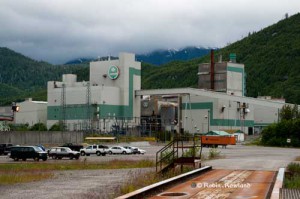The Joint Review Panel hearings on the Northern Gateway pipeline are less than 48 hours from now. The media are packing their bags and coming to Kitimat (or perhaps Terrace since this town is booked solid).
The propaganda war, and it can only be called a propaganda war, is in full force, driven mostly by right wing columnist Ezra Levant and his Ethical Oil organization, objecting to “foreign intervenors in the pipeline hearings at another site OurDecision.ca
This now seems to have widespread support, in a Twitter debate last night, many even moderate conservatives and even moderate Albertans were saying there is too much foreign influence in the JRP hearings.
I have one question for these people. Where were you in June? On a beach?
It was in June that the National Energy Board held hearings on the first of the three proposed Liquified Natural Gas projects in Kitimat. No media hordes descended on Kitimat. At those hearings only local reporters showed up and I was the only one that stuck through the entire proceedings. (The NEB did approve the export application)
So when the media quote Levant and his spokesperson Kathryn Marshall, the widespread stories about this malevolent foreign influence are inaccurate because they weren’t in Kitimat in June so they didn’t hear all those deep Texas drawls in the hearing room at the Riverlodge Recreation Centre.
Although a lot of good reporters are coming into town this week, they’ll all be gone by Thursday morning when the JRP hearings move on to Terrace.
So in today’s Sun Media papers Levant says:
Who should decide whether Canada should build an oil pipeline to our west coast — Canadian citizens or foreign interests?
That’s what the fight over the Northern Gateway pipeline is about. Sure, it’s also about $20 billion a year for the Canadian economy and thousands of jobs. It’s about opening up export markets in Asia. It’s about enough new tax dollars to pay for countless hospitals and schools.
But it’s really about Canadian sovereignty. Do we get to make our own national decisions, or will we let foreign interests interfere?
The answer should be obvious to any self-respecting Canadian: This is a Canadian matter, and Canadians should decide it.
Why weren’t Levant and the rest of the blue-eyed sheikh crowd (OK they don’t all have blue yes but you know what I mean) across the Rockies here in June objecting to those Americans interfering in Canadian affairs with their plans to export liquefied natural gas to Asia?
Who is behind the Kitimat LNG project? Well, the KMLNG partners are Houston, Texas based Apache Corporation, Houston, Texas based EOG Resources and Encana, a company that originated in Canada but now has extensive operations in the United States and around the world.
The second LNG project, which is now before the National Energy Board, is BC LNG, a partnership between a Houston, Texas-based energy company and the Haisla First Nation here in Kitimat.
The third LNG project is coming from energy giant Royal Dutch Shell.
When are we going to see Ethical Oil and all those conservative columnists objecting to American participation when the NEB holds hearings on the second and third LNG projects?
This goes all the way to the centre of power. Stephen Harper objects to the Northern Gateway hearings being “hijacked by foreign money.” I notice the Prime Minister didn’t object to the hearings in June with American companies Apache and EOG investing in a natural gas pipeline. Cabinet ministers Joe Oliver and Peter Kent are also concerned about foreign influence on pipeline projects. That is they are only worried about possible foreign influence when it comes to the environment. Foreign influences that are building natural gas pipelines and LNG terminal facilities are perfectly fine, thank you.
Blaming “foreign influence”, of course, is one of the oldest dirty tricks in the political playbook. In recent days Russian Prime Minister Vladimir Putin has blamed foreign influence for the demonstrations against the rigged election in that country. In Syria, Bashir al-Assad is still blaming “foreign agitators” for the revolt against his regime. Before they were ousted, both Hosni Mubarak of Egypt and Mohamar Gaddafi of Libya blamed “foreign agitators” for the Arab Spring. Go to Google News and type in “foreign influence” or “foreign agitators” and now that Google News also searches news archives, you can find stories of politicians all over the world blaming foreigners for their troubles going back to the turn of the last century.
It’s just sad to see Canada’s leading politicians and the major media joining that sorry tradition.
Note Natural Gas is not bitumen
Some in the media seems to be puzzled that most of the people in northern British Columbia are not objecting to the liquified natural gas projects. The media seem puzzled that KM LNG has been able to reach agreements with First Nations along the natural gas pipeline routes when Enbridge can’t.
(One factor is that Enbridge got off on the wrong foot with First Nations and things have generally gone downhill from there, leading people in northwest BC to question the general competence of Enbridge management.)
The answer is that natural gas is not bitumen. Natural gas is known factor. Bitumen, despite the thousands of pages of documents field by Enbridge with the JRP, is an unknown factor since there has never been a major bitumen disaster.
The worst case scenario, a catastrophic LNG ship explosion, could cause a huge forest fire. A natural gas pipeline breach under the right conditions could start a big forest fire. The environment of northwestern British Columbia has evolved to deal with fires. After such an incident, nature would take over and the forest would eventually come back. It is likely that the forest would take longer to recover than it would from a lightning strike fire, but the forest would recover. Bitumen leaking into salmon spawning rivers would kill the rivers. Bitumen stuck at the deep and rocky bottom of Douglas Channel would contaminate the region, probably for centuries.
It’s that simple.
Related Terrace Daily No Apology Forthcoming by Gerald Amos
 The Apache Corporation website has a posting for a construction manager for the Kitimat LNG project.
The Apache Corporation website has a posting for a construction manager for the Kitimat LNG project.




